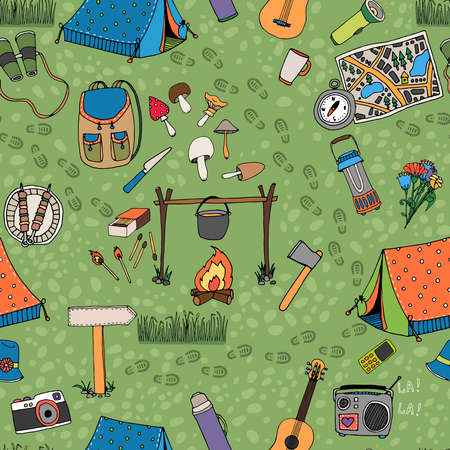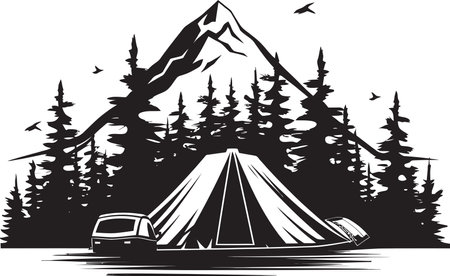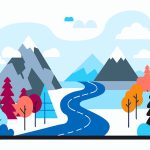1. Choosing the Perfect Destination
Planning a fishing and camping combo trip starts with picking the right spot. The perfect destination should offer not only great fishing but also beautiful, comfortable places to set up camp. To find that sweet spot, you’ll need to think about what kind of fish you want to catch, the type of environment you enjoy, and what kind of amenities you need nearby.
Think About the Fish You Want to Catch
Start by deciding what species of fish youre hoping to reel in. Different areas across the U.S. are known for different types of fish. Whether it’s bass in the South, trout in the Rockies, or salmon in the Pacific Northwest, your target species will help narrow down your location options.
Popular Fishing Targets by Region
| Region | Common Fish Species | Best Time to Go |
|---|---|---|
| Southeast (e.g., Florida, Georgia) | Largemouth Bass, Redfish | Spring through Fall |
| Northeast (e.g., New York, Maine) | Trout, Smallmouth Bass | Late Spring to Early Fall |
| Midwest (e.g., Minnesota, Michigan) | Pike, Walleye | Summer |
| West (e.g., Colorado, Montana) | Rainbow Trout, Cutthroat Trout | Late Spring through Summer |
| Pacific Northwest (e.g., Oregon, Washington) | Salmon, Steelhead | Fall for Salmon; Winter for Steelhead |
Consider Climate and Seasonality
The time of year plays a big role in both fishing success and camping comfort. For example, summer might be great for mountain lakes but too hot for lowland rivers in the South. Check seasonal patterns like water levels and fish activity before locking in your travel dates.
Amenities: What Do You Need Nearby?
If youre going off-grid, make sure you’re prepared to be self-sufficient. But if youd rather have some comforts like restrooms, picnic tables, or even a bait shop close by, look for established campgrounds near popular fishing spots. Many state parks across the U.S. offer both great campsites and easy access to fishing waters.
Amenities Checklist:
- Campsite availability (reservations may be required)
- Bait and tackle shops nearby
- Canoe/kayak rentals if fishing from shore is limited
- Fire pits and picnic areas at campsites
- Running water and restrooms
- Paved or gravel roads for easy access
Do Some Research Online or Talk to Locals
You can find a lot of helpful info on state park websites or apps like Fishbrain and AllTrails. Local bait shops are also a goldmine of insider knowledge—don’t hesitate to ask them where the fish are biting and which campsites are best during your visit.
Selecting the right destination sets the tone for your whole adventure. With some thoughtful planning based on fish species, climate conditions, and available amenities, youll be well on your way to an unforgettable fishing and camping trip.
2. Essential Gear for a Dual Adventure
When youre planning a combo trip that includes both fishing and camping, having the right gear can make or break your experience. Whether youre casting a line in a quiet lake or roasting marshmallows under the stars, you’ll want to be well-prepared. Here’s a breakdown of the must-have items to pack for a smooth and enjoyable outdoor adventure.
Fishing Essentials
Let’s start with the basics you’ll need for a successful day on the water:
| Item | Description |
|---|---|
| Fishing Rod & Reel | A medium-action spinning rod is versatile for most freshwater fish in the U.S. |
| Tackle Box | Include hooks, sinkers, bobbers, lures, extra line, and needle-nose pliers. |
| Bait | Live bait like worms or minnows, or artificial lures based on target species. |
| Fishing License | Make sure you’re licensed according to your state’s regulations. |
| Cooler or Stringer | For keeping your catch fresh until it’s time to cook. |
| Polarized Sunglasses | Reduces glare and helps spot fish beneath the surface. |
Camping Must-Haves
After a long day of fishing, youll want your campsite ready to relax and recharge:
| Item | Description |
|---|---|
| Tent & Ground Tarp | A weather-resistant tent sized for your group, plus a tarp for underneath to keep moisture out. |
| Sleeping Bag & Pad | Select based on season and temperature rating; pads add comfort and insulation. |
| Camp Stove or Grill | Portable cooking equipment makes preparing meals easy—great for cooking your catch! |
| Cooler with Ice Packs | Keeps food and drinks cold; choose one with good insulation if youre staying multiple nights. |
| Headlamp or Lanterns | Essential for navigating around camp after sunset. |
| Folding Chairs & Table | Makes eating and relaxing more comfortable at your campsite. |
Cooking Supplies
You don’t need a full kitchen to cook up something tasty outdoors. Heres what you should bring:
- Pots, pans, and utensils (forks, knives, spatula)
- Cutting board and sharp knife (especially handy for cleaning fish)
- Bottle opener/can opener/multi-tool
- Dishes or reusable containers for serving food
- Papertowels, biodegradable soap, sponge, trash bags for cleanup
- Seasonings and oil/spray for cooking (salt, pepper, garlic powder are staples)
Safety & Comfort Gear
Your safety should always come first when youre out in nature. Don’t leave home without:
- First Aid Kit – include bandages, antiseptic wipes, tweezers, allergy meds, and pain relievers.
- Sunscreen & Bug Spray – protect against sunburns and insect bites.
- Map/GPS/Compass – especially important if you’re heading off-grid or exploring new terrain.
- Weather-Appropriate Clothing – think layers: base layer, insulating layer, waterproof outer layer.
- Pocket Knife or Multi-tool – endlessly useful around camp and while fishing.
- Fire Starters – waterproof matches or lighter plus kindling/fire starters if fires are allowed.
Packing Tip:
Create separate bins or duffel bags labeled “Fishing Gear” and “Camping Gear” so you can easily find what you need when you need it. This also keeps things organized when loading up your vehicle or boat!
Bonus Tip:
If space allows, bring along a folding wagon or heavy-duty backpack to help transport gear from your car to the campsite or fishing spot with ease. It’ll save time—and your back!
The right gear makes all the difference between a frustrating trip and an unforgettable one. With this checklist in hand, you’re one step closer to enjoying a seamless fishing-and-camping adventure that combines the best of both worlds.

3. Planning Your Itinerary
When youre combining fishing and camping into one epic trip, a solid itinerary can make the difference between a smooth adventure and a stressful scramble. The key is to create a flexible schedule that gives you enough structure to hit all your goals—while still leaving room for spontaneity and fun.
Build Around Travel Time
Start by figuring out how long it takes to get to your destination. Whether youre heading to a remote lake in the mountains or a riverside campground closer to home, be realistic about drive times. Don’t forget to factor in gas stops, food breaks, or any last-minute supply runs.
Tip:
If possible, aim to arrive at your campsite with at least 2–3 hours of daylight left. This gives you time to set up camp and settle in before nightfall.
Set Up Camp Before Anything Else
Once you arrive, setting up your campsite should be your top priority. Pitch your tent, get your gear organized, and make sure your food is stored properly (especially if youre in bear country). A well-organized base camp makes everything else easier—and safer.
Plan Around Prime Fishing Hours
Fish are most active during certain times of day—usually early morning and late afternoon. Plan your days so you’re on the water during these peak periods. Use midday hours for meals, rest, or other activities like hiking or exploring.
Daily Sample Schedule
| Time | Activity |
|---|---|
| 6:00 AM – 9:00 AM | Early morning fishing session |
| 9:00 AM – 10:00 AM | Breakfast and cleanup |
| 10:00 AM – 1:00 PM | Relaxing, hiking, or prepping gear |
| 1:00 PM – 2:00 PM | Lunch break |
| 2:00 PM – 5:30 PM | Afternoon fishing session |
| 5:30 PM – 7:00 PM | Dinner prep and cooking |
| 7:00 PM – 9:00 PM | Campfire time or evening walk |
Leave Room for Downtime
You don’t need every minute planned out. One of the best parts of any outdoor trip is just being able to kick back by the fire or watch the stars come out. Make space in your schedule for those quiet moments—theyre just as important as landing the big one.
Be Ready to Adjust
No matter how well you plan, nature can throw curveballs—weather changes, unexpected bites, or even discovering a new fishing spot. Stay flexible and go with the flow when needed. The goal is to enjoy the experience, not stick rigidly to a timeline.
Pro Tip:
If youre traveling with friends or family, talk through the itinerary together before you leave. That way everyone’s on the same page and can help keep things running smoothly.
A well-thought-out itinerary helps balance travel time, prime fishing windows, setup tasks, and relaxing moments—so you get the most out of your fishing and camping combo trip.
4. Staying Safe and Legal
When youre planning a fishing and camping combo trip, its not just about packing your gear and heading out. To truly enjoy the great outdoors in the U.S., you need to stay safe and follow local laws. That means understanding things like fishing licenses, camping permits, wildlife safety, and how to prepare for unpredictable weather. Heres what you need to know before you go.
Fishing Licenses and Camping Permits
Every state has its own rules about fishing and camping, so it’s important to check local regulations before your trip. Most places require a valid fishing license—even for catch-and-release—and many campsites need reservations or permits, especially in national parks or state forests.
Quick Guide to What You Might Need
| Activity | Required Permit/License | Where to Get It |
|---|---|---|
| Fishing (Freshwater) | State Fishing License | State Wildlife Agency Website or Local Retailers |
| Fishing (Saltwater) | Saltwater Fishing License (Some States) | State Fish & Game Department |
| Campsite Use | Camping Permit or Reservation | National Park Service or State Park Website |
Know the Local Regulations
Laws can change from one lake or forest to another. Some areas have catch limits, seasonal restrictions, or special rules for certain fish species. For camping, there may be fire bans or specific rules on where you can pitch a tent. Make sure to look up regulations for your exact destination before you leave home.
Wildlife Safety Tips
Whether youre fishing by a river or camping deep in the woods, chances are youll run into some wildlife. Most animals want nothing to do with people, but it’s still smart to be prepared.
Common Wildlife Encounters and What to Do
| Animal | Safety Tip |
|---|---|
| Bears | Store food in bear-proof containers; never keep food in your tent. |
| Snakes | Watch where you step; avoid tall grass and rocky areas without checking first. |
| Mosquitoes & Ticks | Use insect repellent; wear long sleeves and check for ticks daily. |
Be Ready for Changing Weather
The weather can shift quickly—especially near mountains, lakes, or coastal areas. A sunny morning can turn into a stormy afternoon without much warning. Always bring rain gear, extra layers, and keep an eye on local forecasts.
Packing Essentials for Weather Safety:
- Poncho or waterproof jacket
- Extra socks and warm layers
- Weather radio or app with alerts
- Tarp for shelter if needed
- Sunscreen and hat for sun protection
A little preparation goes a long way when it comes to staying safe and legal on your fishing and camping adventure. With the right licenses, respect for nature, and some common sense precautions, youll be set up for a smooth and fun trip outdoors.
5. Tips for a Sustainable and Enjoyable Trip
Planning a fishing and camping combo trip is all about enjoying nature — but it’s also about protecting it. Whether you’re in the backwoods of Montana or lakeside in Michigan, practicing sustainability ensures that these beautiful spots stay healthy and accessible for future adventurers. Here are some simple, effective tips to keep your trip eco-friendly and fun.
Leave No Trace: Respect Nature Like a Local
The Leave No Trace principles are essential for anyone spending time outdoors in the U.S. These seven simple guidelines help minimize your impact:
| Principle | How to Apply on Your Trip |
|---|---|
| 1. Plan Ahead and Prepare | Check local regulations, pack reusable gear, and bring maps to avoid getting lost. |
| 2. Travel and Camp on Durable Surfaces | Set up camp at designated sites or existing clearings to avoid damaging vegetation. |
| 3. Dispose of Waste Properly | Pack out all trash, including fishing lines and bait containers. |
| 4. Leave What You Find | Don’t take rocks, plants, or artifacts home as souvenirs. |
| 5. Minimize Campfire Impact | Use a camp stove or established fire rings; never leave a fire unattended. |
| 6. Respect Wildlife | Observe animals from a distance, don’t feed them, and secure food properly. |
| 7. Be Considerate of Others | Keep noise down, yield on trails, and respect other campers’ space. |
Clean Your Catch Responsibly
If you plan to eat what you catch — which is part of the fun — be sure to clean your fish responsibly. Here’s how:
- Use a cleaning station if available at your campsite or marina.
- If not, clean fish at least 200 feet away from water sources to avoid contaminating streams or lakes.
- Bury fish guts in a 6–8 inch deep hole far from camp and water sources, or pack them out in sealed bags if required by local rules.
This not only keeps the area clean but also helps prevent attracting unwanted wildlife like bears or raccoons.
Preserve Natural Habitats
Your favorite fishing hole or scenic campsite is part of a larger ecosystem. Heres how you can help preserve it:
- Avoid trampling riverbanks and delicate vegetation — stick to worn paths when possible.
- Practice catch-and-release when appropriate, especially with endangered species or during spawning seasons.
- Use barbless hooks to reduce injury to fish you plan to release.
Sustainable Gear Choices
Your gear choices matter too! Opt for reusable items whenever possible:
| Swap This | For This |
|---|---|
| Disposable plastic water bottles | Refillable stainless steel or BPA-free bottle |
| Chemical-heavy insect repellents | Eco-friendly, DEET-free options |
| Single-use utensils & plates | Bamboo or metal camping cutlery sets |
Treating nature kindly doesn’t mean giving up comfort — it just means being thoughtful with your choices so that others can enjoy these spaces just like you do.


